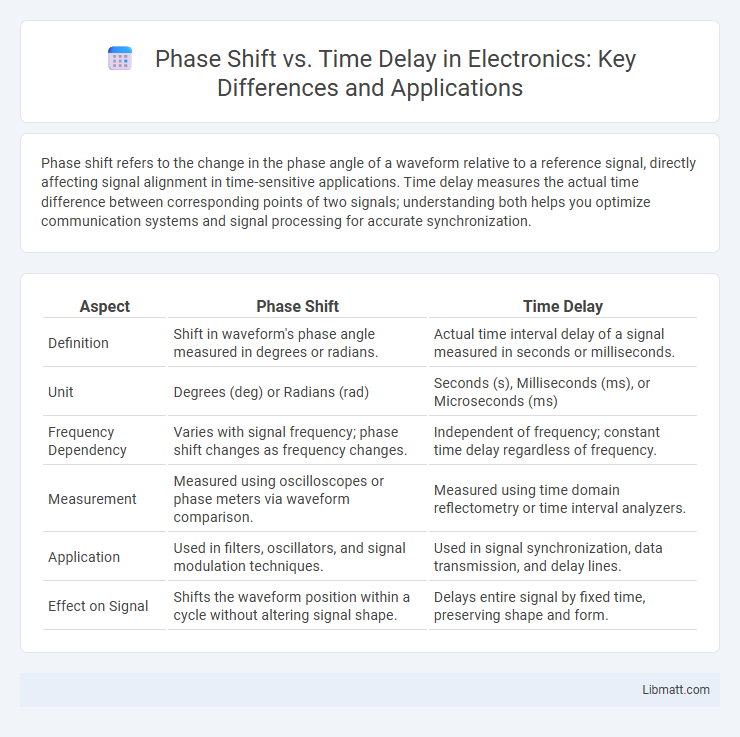Phase shift refers to the change in the phase angle of a waveform relative to a reference signal, directly affecting signal alignment in time-sensitive applications. Time delay measures the actual time difference between corresponding points of two signals; understanding both helps you optimize communication systems and signal processing for accurate synchronization.
Table of Comparison
| Aspect | Phase Shift | Time Delay |
|---|---|---|
| Definition | Shift in waveform's phase angle measured in degrees or radians. | Actual time interval delay of a signal measured in seconds or milliseconds. |
| Unit | Degrees (deg) or Radians (rad) | Seconds (s), Milliseconds (ms), or Microseconds (ms) |
| Frequency Dependency | Varies with signal frequency; phase shift changes as frequency changes. | Independent of frequency; constant time delay regardless of frequency. |
| Measurement | Measured using oscilloscopes or phase meters via waveform comparison. | Measured using time domain reflectometry or time interval analyzers. |
| Application | Used in filters, oscillators, and signal modulation techniques. | Used in signal synchronization, data transmission, and delay lines. |
| Effect on Signal | Shifts the waveform position within a cycle without altering signal shape. | Delays entire signal by fixed time, preserving shape and form. |
Introduction to Phase Shift and Time Delay
Phase shift measures the angular displacement between corresponding points of two periodic signals, typically expressed in degrees or radians, indicating how much one waveform leads or lags another. Time delay quantifies the actual time difference for a signal to reach a certain point, often measured in seconds or milliseconds, reflecting propagation or processing latency. Both concepts are crucial in signal processing and communications for analyzing waveform synchronization and system response times.
Definition of Phase Shift
Phase shift refers to the change in the phase angle of a waveform relative to a reference signal, typically measured in degrees or radians. It indicates how much a wave is shifted horizontally along the time axis without altering its frequency or amplitude. Unlike time delay, which measures the absolute time difference between signals, phase shift quantifies the angular displacement within one signal cycle.
Understanding Time Delay
Time delay refers to the time it takes for a signal to propagate from one point to another, measured in seconds or milliseconds, and directly affects the timing and synchronization in communication systems. Unlike phase shift, which describes the angular difference between waveforms, time delay quantifies actual temporal displacement, crucial for accurate data transmission and signal processing. Precise measurement and management of time delay ensure minimal distortion and effective coordination in networks, control systems, and audio engineering.
Mathematical Relationship Between Phase Shift and Time Delay
The mathematical relationship between phase shift (ph) and time delay (t) is defined by the equation ph = 2pft, where f represents the frequency of the signal. This equation indicates that the phase shift is directly proportional to both the frequency and the time delay. Understanding this relationship allows you to analyze signal processing and communication systems more effectively by converting between time domain delays and their corresponding phase shifts in the frequency domain.
Phase Shift vs Time Delay: Key Differences
Phase shift represents the angular displacement of a waveform relative to a reference point, measured in degrees or radians, while time delay quantifies the absolute time offset between signals, measured in seconds. Phase shift depends on frequency, showing a proportional relationship where the same time delay results in different phase shifts at varying frequencies. Time delay remains constant regardless of frequency, making it a time-domain parameter, unlike phase shift, which is a frequency-domain characteristic critical in signal processing and communications.
Applications of Phase Shift in Engineering
Phase shift is crucial in engineering applications such as signal processing, communication systems, and control systems where precise timing and synchronization are needed. Your ability to manipulate phase shift enhances filter design, modulation techniques, and stability analysis in feedback loops. Time delay, while related, primarily impacts signal propagation and system response times, but phase shift directly influences waveform alignment and interference patterns.
Real-World Uses of Time Delay
Time delay is crucial in real-world applications such as telecommunications, where it ensures signal synchronization across networks to maintain data integrity. In control systems, time delay helps in stabilizing processes and preventing oscillations by accounting for reaction times within feedback loops. Your systems benefit from precise time delay management to improve performance and reliability in dynamic environments.
Impact on Signal Processing and Communication
Phase shift and time delay both affect signal integrity but in distinct ways critical to signal processing and communication systems. Phase shift alters the phase angle of a waveform, potentially causing signal distortion or misalignment in systems relying on phase coherence, such as phase-locked loops and quadrature amplitude modulation. Time delay impacts the timing of signal arrival, which can lead to synchronization errors and degradation in digital communication, making precise delay compensation essential for maintaining data integrity and reducing bit error rates.
Visualization: Phase Shift and Time Delay in Waveforms
Phase shift in waveforms is visualized as a horizontal displacement between two periodic signals, where one wave leads or lags the other by a specific angle measured in degrees or radians. Time delay represents a temporal offset quantified in seconds, showing how much one signal is shifted in time relative to another without altering the waveform shape. Graphical comparison of these concepts highlights that phase shift depends on frequency, causing non-linear time displacement across frequencies, while time delay remains constant across all frequencies.
Conclusion: Choosing Between Phase Shift and Time Delay
Choosing between phase shift and time delay depends on the specific signal processing requirements and system characteristics. Phase shift alters the signal's phase angle without changing the time axis, ideal for applications requiring frequency-domain manipulation. Time delay shifts the entire signal waveform in time, which is essential for synchronization tasks where preserving waveform shape over time is critical for your system's performance.
Phase Shift vs Time Delay Infographic

 libmatt.com
libmatt.com